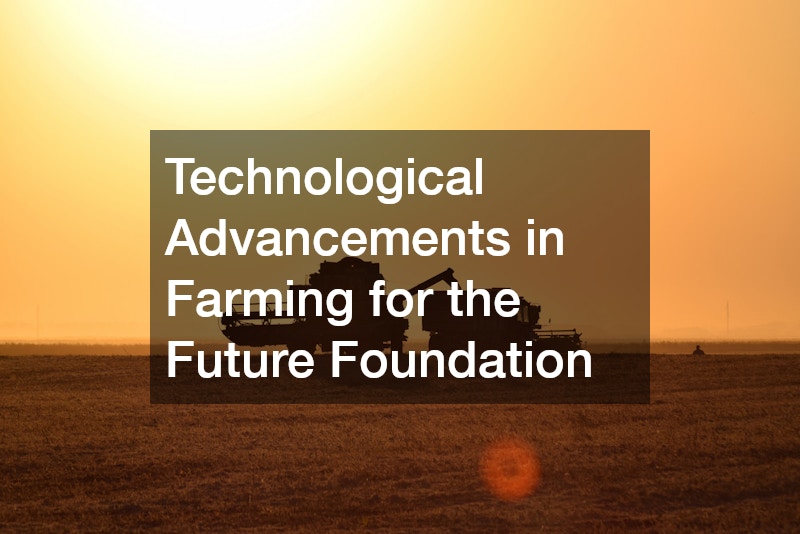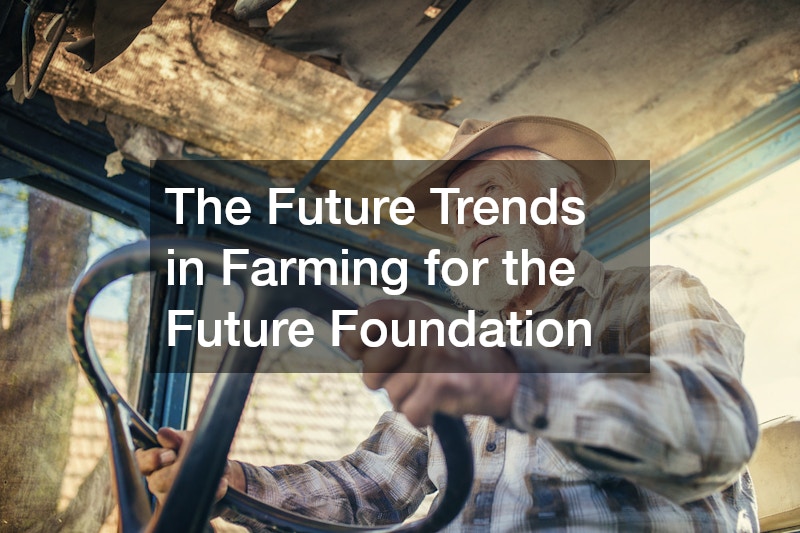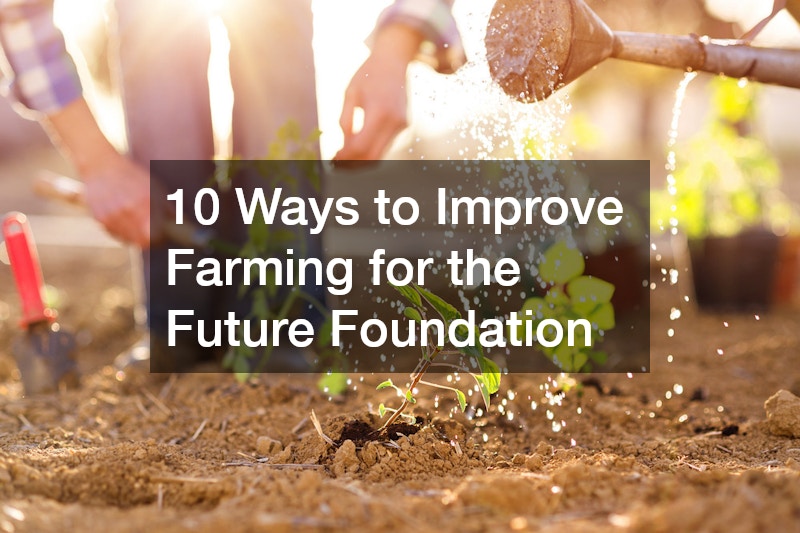The agriculture sector must adapt and embrace new technologies and methodologies to enhance productivity and ensure food security in farming for the future foundation. This article outlines ten strategies that significantly improve farming practices and help cultivate a more sustainable agricultural landscape.
1. Technological Advancements in Farming for the Future Foundation

1.1 The Role of Precision Agriculture
Precision agriculture utilizes advanced farm equipment to enhance farming efficiency and crop management. By employing GPS technology and data analytics, farmers can monitor their fields with exceptional accuracy, improving plant metabolism and yield outcomes. This targeted approach minimizes waste and optimizes inputs like water, fertilizers, and pesticides. Moreover, reliable tractors equipped with precision tools enable farmers to implement data-driven decisions seamlessly.
1.2 Implementing IoT in Agriculture
The Internet of Things (IoT) is revolutionizing the agricultural landscape by facilitating real-time data collection and analysis. Sensors placed throughout industrial land can monitor soil moisture, temperature, and nutrient levels, enabling farmers to make informed decisions. This connectivity allows for more precise irrigation and fertilization, reducing resource waste. Additionally, IoT systems can alert farmers to pest infestations or diseases, enabling timely interventions that safeguard crop health.
1.3 Benefits of Automation and Robotics
Automation and robotics are transforming farming operations, streamlining labor-intensive tasks, and increasing productivity. For instance, robotic systems can handle planting, harvesting, and weeding with greater speed and precision than human laborers. This not only reduces labor costs but also minimizes human error, leading to more consistent crop quality. Furthermore, automated outdoor pest control systems can target pests effectively, reducing the need for harmful chemical treatments. Refer to your local farm equipment company for updates on future robotic innovations.
2. Sustainable Farming Practices
2.1 Organic Farming Techniques
Organic farming emphasizes the use of natural processes and materials to cultivate crops, minimizing reliance on synthetic chemicals. By adopting organic practices, farmers can enhance soil health and promote biodiversity. Techniques such as composting, cover cropping, and natural pest control methods contribute to a more resilient farming ecosystem. Furthermore, organic farming aligns with the growing consumer demand for clean, pesticide-free produce.
2.2 Crop Rotation and Diversification
Crop rotation and diversification are vital sustainable farming practices that help maintain soil fertility and reduce pest pressures. By rotating different crops in a field, farmers can disrupt pest life cycles and minimize disease incidence. Additionally, diverse crop planting enhances soil health by improving nutrient availability and reducing erosion. This practice allows farmers to mitigate risks associated with market fluctuations by diversifying their produce.
2.3 Reducing Chemical Usage
The reduction of chemical inputs is crucial for sustainable farming. Farmers can adopt integrated pest management (IPM) techniques that emphasize prevention and biological controls over synthetic pesticides. Utilizing organic fertilizers, such as compost and manure, can improve soil fertility without harmful side effects. Additionally, reducing herbicide and pesticide use can enhance biodiversity by protecting beneficial insects and wildlife.
3. The Effects of Climate Change on the Future of Farming
3.1 Impact on Crop Yields
Climate change poses significant challenges to crop yields due to shifting weather patterns and extreme events. Increased temperatures and altered precipitation can negatively impact plant metabolism, leading to reduced productivity. Farmers must adapt their practices to mitigate these effects, such as selecting more resilient crop varieties. Understanding local climate projections can help farmers make informed decisions regarding planting and harvesting schedules. Addressing the impacts of climate change is crucial for ensuring future food security.
3.2 Adapting to Weather Extremes
Farmers face increasing weather extremes, including droughts and floods, which threaten their livelihoods. Implementing resilient farming practices, such as improved irrigation systems, can help mitigate these challenges. Techniques like drip irrigation ensure efficient water usage and reduce waste during dry spells. Conversely, establishing proper drainage systems can protect crops from flooding.
3.3 Mitigation Strategies
To address climate change, farmers can adopt various mitigation strategies that reduce greenhouse gas emissions. Practices such as agroforestry and cover cropping not only sequester carbon but also improve soil health. Farmers can also implement rotational grazing systems that enhance pasture resilience while capturing atmospheric carbon. Moreover, utilizing renewable energy sources for farm operations can significantly lower carbon footprints.
4. Benefits of Urban Farming

4.1 Reducing Food Miles
Urban farming initiatives play a critical role in reducing food miles, contributing to lower carbon emissions associated with transportation. By cultivating food close to consumers, urban farms minimize the environmental impact of long-distance shipping. This not only benefits the planet but also provides fresh, nutritious produce to urban populations. Furthermore, shorter supply chains increase food security by reducing reliance on external sources. Emphasizing local food production is vital for sustainable urban development.
4.2 Community Engagement and Education
Urban farms serve as valuable community resources, fostering engagement and education about sustainable practices. These farms can host workshops, school programs, and volunteer opportunities, empowering community members to participate in food production. By promoting awareness of food systems and environmental issues, urban farming initiatives can inspire a culture of sustainability. Additionally, community gardens can enhance social cohesion and improve mental well-being among participants.
4.3 Vertical Farming Potential
Vertical farming represents an innovative solution for urban agriculture, maximizing space efficiency in densely populated areas. By utilizing controlled environments and hydroponic systems, vertical farms can produce fresh crops year-round. This method not only conserves water but also minimizes land usage, making it ideal for urban settings. Furthermore, vertical farms can reduce the need for pesticides, contributing to healthier food production. In addition, hydroseeding is essential in maintaining the livelihood of crops and livestock.
5. Improving Water Management
5.1 Efficient Irrigation Systems
Water management is critical for sustainable farming, especially in regions facing water scarcity. Implementing efficient irrigation systems, such as drip or subsurface irrigation, ensures precise water delivery to crops. These methods minimize evaporation and runoff, conserving water resources. Additionally, farmers can monitor soil moisture levels using sensors or a water filtration system, allowing for timely irrigation adjustments.
5.2 Water Conservation Techniques
Adopting water conservation techniques is essential for sustainable agriculture. Practices such as mulching and crop selection can help retain soil moisture and reduce evaporation. Additionally, farmers can explore rainwater harvesting systems to capture and utilize natural precipitation. These systems can provide a supplemental water source during dry spells, enhancing resilience.
5.3 Rainwater Harvesting
Rainwater harvesting offers a sustainable solution for water management in agriculture. Collecting and storing rainwater can significantly reduce reliance on traditional water sources, especially in arid regions. This practice not only conserves resources but also mitigates flooding risks by managing stormwater runoff. Farmers can integrate rainwater harvesting systems into their existing operations, utilizing the collected water for irrigation and livestock needs.
6. Role of Government Policies
6.1 Subsidies and Incentives
Government policies play a crucial role in shaping the future of farming by providing subsidies and incentives. These financial supports encourage farmers to adopt sustainable practices and innovative technologies. For instance, grants for renewable energy installations can help farmers transition to more sustainable operations. Additionally, subsidies for organic farming can boost market access for environmentally friendly products.
6.2 Regulations and Compliance
Adherence to regulations is essential for ensuring safe and sustainable farming practices. Compliance with environmental standards can enhance soil health and water quality, benefiting both farmers and surrounding communities. Moreover, regulations regarding pesticide use and animal welfare promote ethical and responsible farming. Government agencies can provide resources and guidance to help farmers navigate these regulations effectively.
6.3 Support for Research and Development
Investing in research and development is crucial for advancing agricultural practices. Government support for research initiatives can lead to innovative solutions for pressing challenges, such as pest resistance and climate adaptation. By funding agricultural research, policymakers can help farmers access new technologies and methodologies that enhance productivity. Collaborations between universities, research institutions, and agricultural organizations can drive transformative change in farming practices.
7. Adapting to Technological Changes

7.1 Training and Education Programs
As technology continues to evolve, training and education programs become vital for farmers. Providing farmers with the necessary skills and knowledge to implement new technologies can enhance productivity and efficiency. Workshops, online courses, and hands-on training can help farmers navigate advancements in precision agriculture, IoT, and automation. Additionally, mentorship programs can connect experienced farmers with those seeking to adopt innovative practices. Investing in education empowers farmers to thrive in a rapidly changing agricultural landscape and knowledge of insurance services helps in crop preservation.
7.2 Leveraging Data Analytics
Data analytics offers farmers valuable insights that can inform decision-making and optimize operations. By analyzing data from various sources, farmers can identify trends, assess crop health, and predict yields more accurately. This information enables farmers to make informed decisions about planting, irrigation, and pest management. Furthermore, leveraging data can help farmers adapt to market demands, ensuring they produce what consumers want.
7.3 Collaboration with Tech Companies
Collaboration between farmers and technology companies can drive innovation in agriculture. By working together, farmers can identify specific challenges and co-develop tailored solutions that address their needs. These partnerships can lead to the creation of user-friendly technologies that simplify data collection and analysis. Additionally, technology companies can gain valuable insights from farmers, enhancing their products and services.
8. Economic Challenges in Farming
8.1 Market Volatility
Farmers face economic challenges, including market volatility, which can significantly impact their profitability. Fluctuations in crop prices can make it difficult for farmers to plan financially, leading to uncertainty. Diversifying crops and exploring niche markets can help farmers mitigate risks associated with market changes. Additionally, establishing direct-to-consumer sales channels can provide farmers with more stable income sources. Addressing market volatility is essential for ensuring the economic viability of farming operations.
8.2 Access to Capital and Investment
Access to capital is a critical challenge for many farmers, particularly those looking to invest in new technologies or sustainable practices. Securing funding can be difficult, especially for small and medium-sized farms. Financial institutions must recognize the potential of sustainable agriculture and provide tailored loan options for farmers. Moreover, government programs can offer grants and incentives to support farmers in their investment efforts.
8.3 Cost of Technological Adoption
While technology can enhance farming practices, the initial costs of adoption can be prohibitive. Many farmers may struggle to afford advanced equipment and systems, particularly in a competitive market. Financial planning and support are crucial to helping farmers navigate these challenges. Collaborative purchasing programs or shared technology initiatives can make adoption more feasible for smaller operations. By addressing the costs associated with technological adoption, farmers can embrace innovation.
9. Biodiversity Be Preserved in Modern Agriculture
9.1 Habitat Restoration Projects
Habitat restoration projects are essential for preserving biodiversity in modern agriculture. By maintaining natural habitats, farmers can support wildlife populations and enhance ecosystem resilience. Initiatives such as planting native vegetation and restoring wetlands can improve biodiversity and contribute to healthier agricultural landscapes. Furthermore, engaging with local conservation organizations can provide farmers with valuable resources and expertise. Even within their house and land package, farmers must remember to preserve Mother Nature.
9.2 Integrating Conservation Practices
Integrating conservation practices into farming operations is crucial for preserving biodiversity. Techniques such as agroforestry, cover cropping, and reduced tillage can promote healthy ecosystems while enhancing soil fertility. These practices can create habitats for beneficial insects and wildlife, improving pollination and pest control. Additionally, conservation-oriented practices can help mitigate soil erosion and water runoff. By prioritizing conservation, farmers can maintain ecological balance while achieving productive yields.
9.3 Pollinator-Friendly Farming
Supporting pollinator populations is vital for maintaining biodiversity in agriculture. Farmers can adopt practices that create pollinator-friendly environments, such as planting diverse flower species and minimizing pesticide use. Establishing habitat corridors and preserving natural landscapes can enhance pollinator access to food sources. Additionally, farmers can engage in community outreach to raise awareness about the importance of pollinators for food production.
10. The Future Trends in Farming for the Future Foundation

10.1 Rise of Agroecology
Agroecology is gaining momentum as a sustainable farming approach that emphasizes ecological principles. By integrating traditional knowledge with modern practices, agroecology promotes biodiversity and resilience in farming systems. This holistic approach focuses on soil health, water conservation, and community involvement, leading to sustainable food production. Furthermore, agroecological practices can enhance farmers’ adaptability to climate change by fostering diverse cropping systems.
10.2 Innovations in Genetically Modified Organisms
Innovations in genetically modified organisms (GMOs) are paving the way for advancements in agriculture. New genetic engineering techniques can enhance crop resilience, improve nutritional content, and reduce reliance on chemical inputs. These innovations can address specific agricultural challenges, such as pest resistance and drought tolerance. Moreover, public perception and regulatory frameworks surrounding GMOs are evolving, allowing for more widespread adoption.
10.3 Expansion of Blockchain in Food Supply Chain
Blockchain technology is emerging as a powerful tool for enhancing transparency in the food supply chain. By providing immutable records of production and distribution, blockchain can improve traceability and build consumer trust. This technology can also facilitate direct transactions between farmers and consumers, streamlining the supply chain.
Embracing innovative strategies is essential for the Farming for the Future Foundation to drive positive change in the agriculture sector. By focusing on technology, sustainability, and effective resource management, farmers can enhance productivity while preserving the environment.

